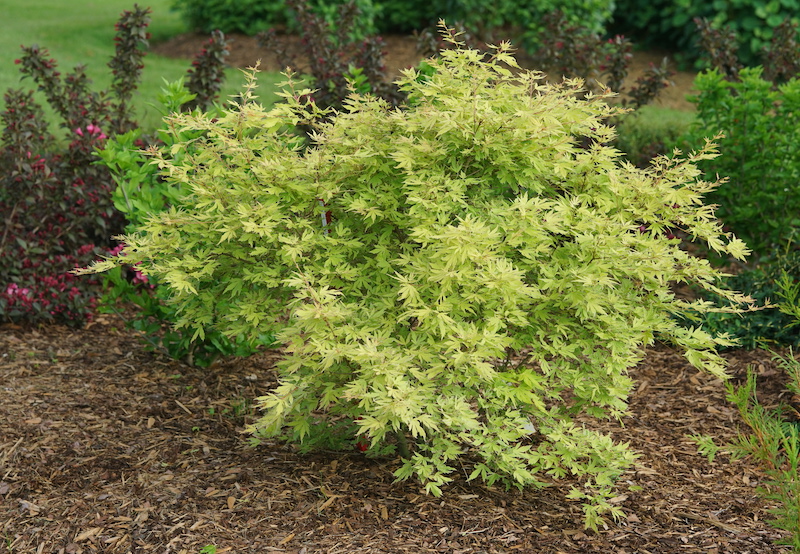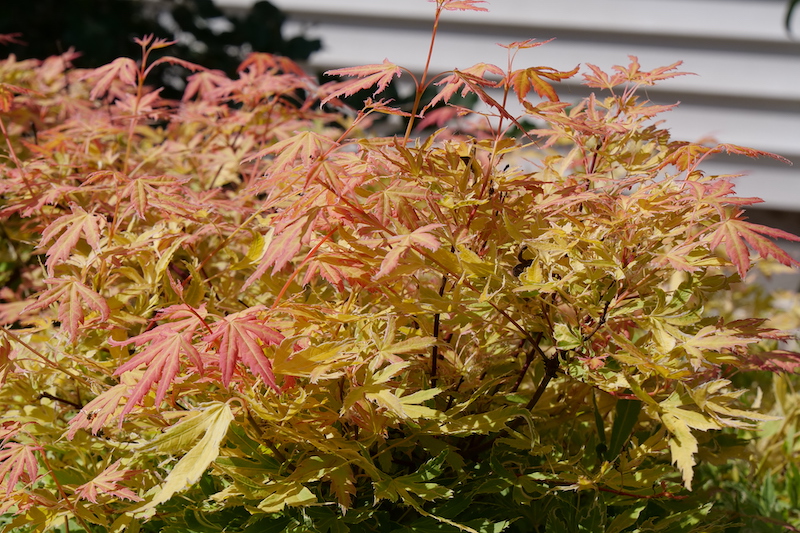Growing Japanese Maple
Grown for its brilliant, lace-like foliage, the Japanese Maple tree is truly an exquisite specimen. This East Asian native is known to add a sophisticated element to your landscape with its color-changing foliage. Throughout the growing season, the foliage will glow in yellow, orange, and red. Small purple flowers bloom in the spring.
Also known as Acer palmatum, these trees are typically hardy in USDA zones 6-9. Japanese maples thrive in dappled sunlight, preferring morning sun and afternoon shade. They can reach up to 10-25 feet tall.

Planting Japanese Maple
Plant your tree in a moist but well-draining location that gets part to full shade. For best results, dig a hole that is no more than double the volume of the root ball–-about the same depth and twice the width. Place the rootball so the top is slightly above the soil level, creating a visible root flare. Japanese Maples thrive in slightly acidic soil, so amend your soil as necessary. Topdress the root zone with a layer of compost to conserve moisture and improve the soil.
Do not fertilize newly planted trees; wait until the second growing season to feed using a slow-release fertilizer.
Watering Japanese Maple
Japanese Maples like to be kept moist but not soggy for best growth results. Water regularly to keep the surrounding soil slightly moist until the Japanese maple tree is well established. Adding a 3-inch layer of mulch will help to retain moisture. However, pull the mulch away from the trunk so as to prevent disease. In periods of drought, be sure to water your Japanese Maple thoroughly to prevent stress on the tree. Slightly cut back on watering during the late summer to intensify the fall colors in the foliage.
Fertilizing Japanese Maple
The best time to fertilize is in the springtime. Use a granular, slow-release shrub and tree food at a half-strength dosage. There are a few good specific Japanese Maple fertilizers on the market, for example, Fox Farm’s 4-8-5 product.
Avoid giving the tree too much nitrogen, especially within the first few years of planting. Using too much fertilizer too soon may scorch your plant and lead to weak growth. Apply the feeding at least 1 foot away from the trunk to further avoid fertilizer burn.

Pruning Japanese Maple
Learning to correctly prune a Japanese Maple is a fun hobby and can transform your tree into an artistic focal point in the landscape. This type of tree will benefit from lower branches being left on for a few years until the trunk is stronger. Remove dead or damaged branches in the late winter to early spring before new growth appears.
You may prune to maintain a desired shape or to control size. Focus on opening up the canopy to let more light reach all the branches and removing crossing branches or branches that do not follow the natural shape of the tree. Preferably, prune your maple tree late in the summer during mid July to late August. Avoid trimming too much from the top of the tree as this could harm root development.
Caring For Japanese Maple in Pots
Japanese Maple trees make gorgeous bonsais. Ensure that you do not use a container that is too large. A large container may dry out too slowly, retaining too much moisture around the roots and causing disease or pest issues. The container should be no larger than twice the diameter of the root ball and half as deep. After about 2-3 years in a container, the potting soil should be refreshed for healthy growth.
Sunburn is a very common issue for Japanese Maple trees. To reduce the risk of sunburn, place your tree in a semi-shaded location like on a patio or under a pergola and avoid over-pruning.

Winter Care for Japanese Maple
Planted in the ground, most Japanese Maple trees are hardy to USDA zone 5 or 6. However, care should be taken to protect your Japanese Maple tree from excessive wind and heavy, wet snow. Container plants will need more protection than in-ground plants. Protect roots from cold over the winter by insulating the container or moving it to a warm, insulated location. Burlap or bubble wrap can help insulate the container during freeze-thaw cycles. Overwintering your potted maple can be done under the safety of a covered patio, shed, or garage.
 |
Author Chris Link - Published 3-10-2023 |
